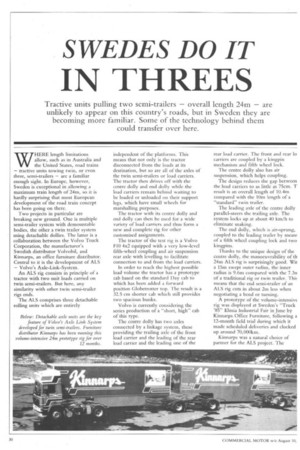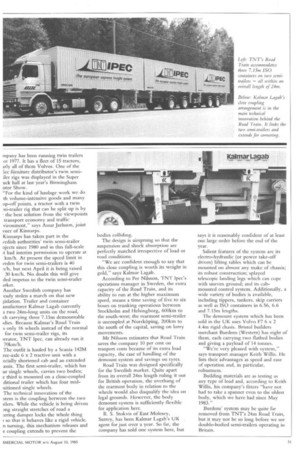SWEDES DO IT
Page 32

Page 33

If you've noticed an error in this article please click here to report it so we can fix it.
IN THREES
Tractive units pulling two semi-trailers — overall length 24m — are unlikely to appear on this country's roads, but in Sweden they are becoming more familiar. Some of the technology behind them could transfer over here.
WHERE length limitations allow, such as in Australia and the United States, road trains —tractive units towing twin, or even three, semi-trailers — are a familiar enough sight. In Europe, however, Sweden is exceptional in allowing a maximum train length of 24m, so it is hardly surprising that most European development of the road train concept has been going on there.
Two projects in particular are breaking new ground. One is multiple semi-trailer system with demountable bodies, the other a twin trailer system using detachable dollies. The latter is a collaboration between the Volvo Truck Corporation, the manufacturer's Swedish distributor Volvobil, and Kinnarps, an office furniture distributor. Central to it is the development of ALS — Volvo's Axle-Link-System.
An ALS rig consists in principle of a tractor with two unit loads carried on twin semi-trailers. But here, any similarity with other twin semi-trailer rigs ends.
The ALS comprises three detachable rolling units which are entirely independent of the platforms. This means that not only is the tractor disconnected from the loads at its destination, but so are all of the axles of the twin semi-trailers or load carriers. The tractor then drives off with the centre dolly and end dolly while the load carriers remain behind waiting to be loaded or unloaded on their support legs, which have small wheels for marshalling purposes.
The tractor with its centre dolly and end dolly can then be used for a wide variety of load carriers and thus form a new and complete rig for other customised assignments.
The tractor of the test rig is a Volvo F10 4x2 equipped with a very low-level fifth-wheel coupling and air suspension rear axle with levelling to facilitate connection to and from the load carriers.
In order to reach the highest possible load volume the tractor has a prototype cab based on the standard Day cab to which has been added a forward position Globetrotter top. The result is a 32.5 cm shorter cab which still provides two spacious bunks.
Volvo is currently considering the series production of a "short, high" cab of this type.
The centre dolly has two axles connected by a linkage system, these providing the trailing axle of the front load carrier and the leading of the rear load carrier and the leading one of the rear load carrier. The front and rear lo carriers are coupled by a kingpin mechanism and fifth wheel lock.
The centre dolly also has air suspension, which helps coupling.
The design reduces the gap between the load carriers to as little as 75cm. T result is an overall length of 10.4m compared with the 10m length of a "standard" twin trailer.
The leading axle of the centre dolly parallel-steers the trailing axle. The system locks up at about 40 km/h to eliminate snaking.
The end dolly, which is air-sprung, coupled to the leading trailer by mean' of a fifth wheel coupling lock and two kingpins.
Thanks to the unique design of the centre dolly, the manoeuvrability of th 24m ALS rig is surprisingly good. Wit a 15m swept outer radius, the inner radius is 9.6m compared with the 7.3n of a traditional rig or twin trailer. This means that the end semi-trailer of an ALS rig cuts in about 2m less when negotiating a bend or turning.
A prototype of the volume-intensive rig was displayed at Sweden's "Truck '85" Elmia Industrial Fair in June by Kinnarps Office Furniture, following a 12-month field trial during which it made scheduled deliveries and clocked up around 70,000km.
Kinnarps was a natural choice of partner for the ALS project. The tnpany has been running twin trailers ce 1977. It has a fleet of 15 tractors, irly all of them Volvos. One of the ice furniture distributor's twin semiiler rigs was displayed in the Super tick hall at last year's Birmingham otor Show.
"For the kind of haulage work we do th volume-intensive goods and many op-off points, a tractor with a twin ni-trailer rig that can be split up is by • the best solution from the viewpoints transport economy and traffic vironment," says Assar jarlsson, joint vner of Kinnarps.
Kinnarps has taken part in the iedish authorities' twin semi-trailer ojects since 1980 and in this full-scale '4 had interim permission to operate at km/h. At present the speed limit in veden for twin semi-trailers is 40 D/h, but next April it is being raised 30 km/h. No doubt this will give ded impetus to the twin semi-trailer arket.
Another Swedish company has • eady stolen a march on that new ;islation. Trailer and container anufacturer Kalmar Lagab currently s two 24m-long units on the road, ch carrying three 7.15m demountable idies. Because Kalmar's Road Train s only 16 wheels instead of the normal for twin semi-trailer rigs, its ierator, TNT Ipec, can already run it 70km/h.
The outfit is hauled by a Scania 142M ree-axle 6 x 2 tractive unit with a ccially shortened cab and an extended assis. The first semi-trailer, which has ur single wheels, carries two bodies; e third is mounted on a close-coupled ditional trailer which has four mid
■ sitioned single wheels.
The technical innovation of the stem is the coupling between the two tilers. While the vehicle is being driven mg straight stretches of road a tering damper locks the whole thing ) so that it behaves like a rigid vehicle. n turning, this mechanism releases and e coupling extends to prevent the bodies colliding.
The design is airsprung so that the suspension and shock absorption are perfectly matched irrespective of load or road conditions.
"We arc confident enough to say that this close coupling is worth its weight in gold," says Kalmar Lagab.
According to Per Nilsson, TN'1' Ipec's operations manager in Sweden, the extra capacity of the Road Train, and its ability to run at the higher maximum speed, means a time saving of five to six hours on trunking operations between Stockholm and Helsingborg, 600km to the south-west; the rearmost semi-trailer is uncoupled at Norrkoping, 200km to the south of the capital, saving on lorry movements.
Mr Nilsson estimates that Road Train saves the company 10 per cent on tranport costs because of its extra load capacity, the case of handling of the demount system and savings on tyres.
Road Train was designed specifically for the Swedish market. Quite apart from its overall 24m length ruling it out for British operation, the overhang of the rearmost body in relation to the wheels would also disqualify the idea on legal grounds. However, the body demount system is sufficiently flexible for application here.
R. S. Stokvis of East Molesey, Surrey, has been Kalmar Lagab's UK agent for just over a year. So far, the company has sold one system here, but says it is reasonably confident of at least one large order before the end of the year.
Salient features of the system are its electro-hydraulic (or power take-off driven) lifting tables which can be mounted on almost any make of chassis; its robust construction; splayed telescopic landing legs which can cope with uneven ground; and its cabmounted control system. Additionally, a wide variety of bodies is available, including tippers, tankers, skip carriers as well as ISO containers in 6.56, 6.6 and 7.15m lengths.
The demount system which has been sold in the UK uses Volvo F7 6 x 2 4.4m rigid chasis_ Bristol builders merchant Burdens (Western) has eight of them, each carrying two flatbed bodies and giving a payload of 14 tonnes.
"We're very pleased with system," says transport manager Keith Willis. He lists their advantages as speed and ease of operation and, in particular, robustness.
Building materials are as testing as any type of load and, according to Keith Willis, his company's fitters "have not had to take a spanner even to the oldest body, which we have had since May 1983."
Burdens' system may be quite far removed from TNT's 24m Road Train, but it may not be so long before we see double-bodied semi-trailers operating in Britain.




































































